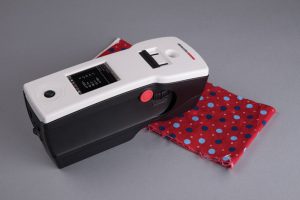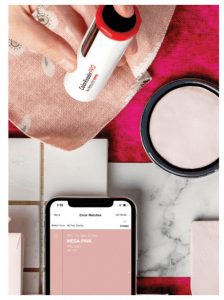
Working from home complicates the color decision making process, but a digital workflow and portable technologies can help the supply chain successfully manage this process.
By Ken Butts
The coronavirus pandemic has impacted nearly every industry across the globe. As it continues, millions of workers are still working from home and most likely will continue to do so into 2021. The same goes for the textile industry, which was certainly not considered a remote work industry prior to this pandemic. Textile and apparel supply chains have spent most of 2020 adapting to the constraints of conducting business remotely.
Color decisions traditionally have been a collaborative effort requiring multiple physical samples and team meetings. Textile brands and mills, although now not working from their typical on-site and in-person environments, are still expected to make color decisions and keep production running without delays, all while maintaining efficiency and quality. As working environments continue to shift, the need for a fully digitalized supply chain in the textile industry that minimizes the need for physical samples has been magnified.
A digital color workflow encompasses everything from initial color selection by designers to the delivery of the final products to a store shelf, plus every step in between. Digitalization brings objectivity and efficiency to an otherwise slow and subjective process made more difficult by current conditions. With a digital workflow, it is possible to accurately and effectively evaluate color acceptability while working from a home computer, reducing the need for physical samples and high shipping costs to get samples to decision makers.
Those who already had a comprehensive digital color management strategy and digital workflow in place prior to the pandemic were able to meet the unique challenges of working remotely with less disruption and minimal down time. Those who did not already rely on a digital strategy had to quickly adapt to keep up.
However, the textile industry is finding ways to successfully manage color in this new age of remote work.

Measuring Color From Home
Measuring color and making important color decisions remotely can be challenging for those who are accustomed to using large benchtop spectrophotometers because they cannot easily be transported for use at home. But it is still important even from home to utilize state-of-the-art equipment to accurately measure color. Because of this, there is an increase in the popularity of sophisticated portable spectrophotometers that support decision making away from the office or mill. Portable spectrophotometers enable color measurements to be made anywhere in the world and instantly transferred across the supply chain to decision makers.
Many of today’s portable spectrophotometers are more accurate than ever before, making them ideal for use in remote work scenarios. Inter-instrument agreement (IIA) is critical to the remote color measurement process when using portable spectrophotometers. IIA refers to how closely two or more spectrophotometers measure the same color. The closer the IIA, the closer the readings will be to one another, and the more likely it is that instrumental color decisions will be consistent across products, materials and locations.
If a user operates a single spectrophotometer in a single location and does not share digital data, IIA is less important. But, when working in home offices and needing to make color decisions in multiple locations, it is essential that the instruments are in excellent agreement with one another. Many portable spectrophotometers have evolved to feature excellent IIA with their benchtop counterparts, making it possible to continue to accurately measure samples in the remote office.
In addition to having the right equipment on hand, it is critical that those measuring color from home follow instrument manufacturer recommendations for environmental conditions to ensure the instrument functions as accurately as possible. Maintain a room that is free of chemical vapors or smoke, and also keep a spectrophotometer, whether portable or not, away from direct sunlight because heating the instrument can lead to inconsistencies in sample measurement. Sample conditioning is also an important consideration — and one that may be a challenge to address in the home office — as some samples can show significant color change with shifts in temperature and humidity.
 On-Screen Color Evaluation From Home
On-Screen Color Evaluation From Home
A potential challenge of elimination of physical samples is any uncertainty that might arise with making color decisions based solely on color measurement data. To support the decision making process, it can be very helpful to display the color of samples on a monitor.
For this process to be reliable, it is critical that the monitor be color calibrated and the lighting in the room be minimized. While monitors cannot display all of the colors that we can see — and some monitors are better than others — that does not mean they cannot be effectively used to support color decisions. Once the monitor is color-calibrated using appropriate technology, a virtual color development process can be implemented from design through to final product quality control.
Empowering Brands With Digital Color
An additional benefit of a digitalized supply chain is that it helps to speed up the textile development and manufacturing processes, making it possible to make product decisions at the point of manufacturing without heavy brand oversight. A digital workflow means the manufacturer can reject samples that they know are outside of specification and make revisions without going through multiple iterations of costly sample shipments. The manufacturer will immediately know if a sample meets the customer’s color expectation and avoid waiting days for a response.
Working from home is likely here to stay, and digitalization is the key to managing color in this age of remote work. Having a digital color management strategy in place has always been an important consideration in the textile industry; however, remote work has showcased the ways in which digital color management can increase speed, efficiency and accuracy across the globe. Digitalized workflows will not only prepare the industry to deal with future disruptions, but also position everyone to meet the future needs of the market. The supply chain will to continue to embrace digitalization and eventually accept it as the standard throughout the industry.
Editor’s Note: Ken Butts has more than 25 years of experience as a solutions consultant in the textile and apparel industry. While with Datacolor, he has analyzed existing product development processes and implemented effective color management solutions for more than 40 of the world’s most well-known retail/brand apparel companies and their global supply chains.
November/December 2020




